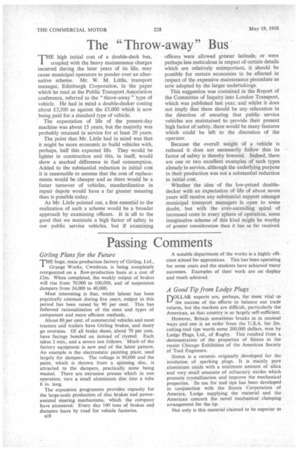The "Throw-away" Bus'
Page 36

If you've noticed an error in this article please click here to report it so we can fix it.
THE high initial cost of a double-deck bus, coupled with the heavy maintenance charges incurred during the later years of its life, may cause municipal operators to ponder over an alternative scheme. Mr. W. M. Little, transport manager, Edinburgh Corporation, in the paper which he read at the Public Transport Association conference, referred to the " throw-away " type of vehicle. He had in mind a double-decker costing about £3,500 as against the £5,000 which is now being paid for a standard type of vehicle.
The expectation of life of the present-day machine was about 15 years, but the majority was probably retained in service for at least 20 years.
The point that Mr. Little had in mind was that it might be more economic to build vehicles with, perhaps, half this expected life. They would be lighter in construction and this, in itself, would show a marked difference in fuel consumption. Added to the substantial reduction in initial cost it is reasonable to assume that the cost of replacements would be cheaper and as there would be a faster turnover of vehicles, standardization in repair depots would have a far greater meaning than is possible today.
As Mr. Little pointed out, a first essential to the realization of such a scheme would be a broader approach by examining officers. It is all to the good that we maintain a high factor of safety in our public service vehicles, but if examining officers were allowed greater latitude, or were perhaps less meticulous in respect of certain details which are relatively unimportant, it should be possible for certain economies to be effected in respect of the expensive maintenance procedure as now adopted by the larger undertakings.
This suggestion was contained in the Report of the Committee of Inquiry into London Transport, which was published last year, and whilst it does not imply that there should be any relaxation in the direction of ensuring that public service vehicles are maintained to provide their present high factor of safety, there would be many features which could be left to the discretion of the operator.
Because the overall weight of a vehicle is reduced it does not necessarily follow that its factor of safety is thereby lowered. Indeed, there are one or two excellent examples of such types already in service, although the underlying purpose in their production was not a substantial reduction in initial cost.
Whether the idea of the low-priced doubledecker with an expectation of life of about. seven years will receive any substantial support amongst municipal transport managers is open to some doubt, but with the ever-ascending spiral of increased costs in every sphere of operation, some imaginative scheme of this kind might be worthy of greater consideration than it has so far received.
















































































































